Log in
Search
Latest topics
» Roger Harris revisitedby TD ABUSER Today at 2:30 am
» My latest doodle...
by batjac Yesterday at 10:05 pm
» Retail price mark-up.. how much is enough?
by gkamysz Yesterday at 9:29 pm
» Happy 77th birthday Andrew!
by roddie Yesterday at 9:22 pm
» My N-1R build log
by GallopingGhostler Yesterday at 3:04 pm
» Tee Dee .020 combat model
by 1/2A Nut Yesterday at 2:43 pm
» Chocolate chip cookie dough.........
by roddie Yesterday at 1:13 pm
» Purchased the last of any bult engines from Ken Enya
by sosam117 Yesterday at 11:32 am
» Free Flight Radio Assist
by rdw777 Yesterday at 9:24 am
» Funny what you find when you go looking
by rsv1cox Wed Nov 20, 2024 3:21 pm
» Landing-gear tips
by 1975 control line guy Wed Nov 20, 2024 8:17 am
» Cox NaBOO - Just in time for Halloween
by rsv1cox Tue Nov 19, 2024 6:35 pm
Cox Engine of The Month
GP F1 Rocket Evo RC airplane build
Page 1 of 1
 GP F1 Rocket Evo RC airplane build
GP F1 Rocket Evo RC airplane build
Hi everyone Finally I have the pics done so I can post the build. The build is complete all that is needed is balancing, so i should be able to post up the pics pretty quick anyway here we go!
First of all, Here is a small peak inside the box, this is a very nice ARF btw was very impressed with how everything went together.

First thing to do is to get things all together, while it's not really necessary to do this, it is good to do because it helps the assembly go quicker the servo's however are a requirement to begin assembly. You will need five (four if you build it electric powered) standard size servo's four high torque and one regular for throttle. I had an NOS Futaba S148 that I used on the throttle.
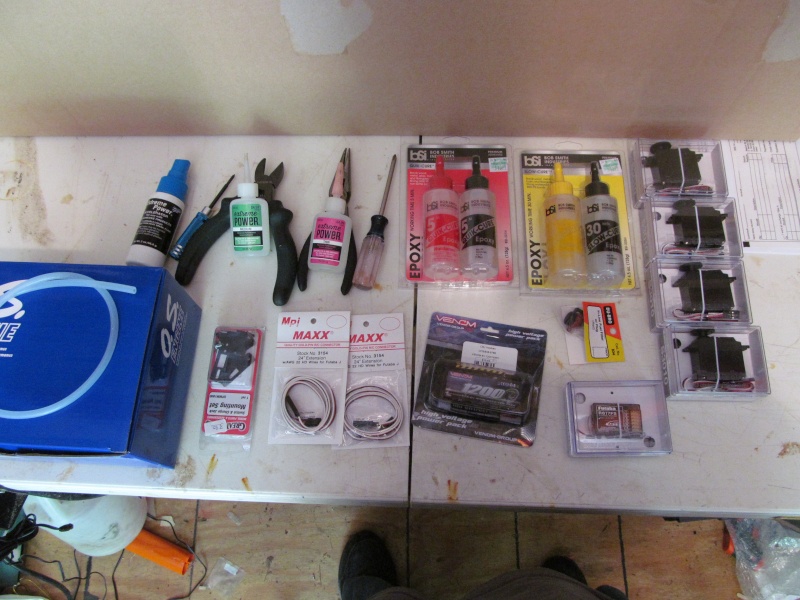
Next step is to open up your Data packet (instruction booklet ect) and lay them out and see what you have this is important because this is where any updates or bulletins addendum's are usually located make spechle note of any updates or error corrections. This is also a good time to open up the instruction manual and study it cover to cover this will make assembly so much easier and you will have an understanding on how everything goes. One thing to note though is to pay attention to the hardware, the manual is not too clear on the type of hardware that's in the hardware bag, the manual gives the length and such but not much info on the head types of the screws. Also make sure you have some thread locker.
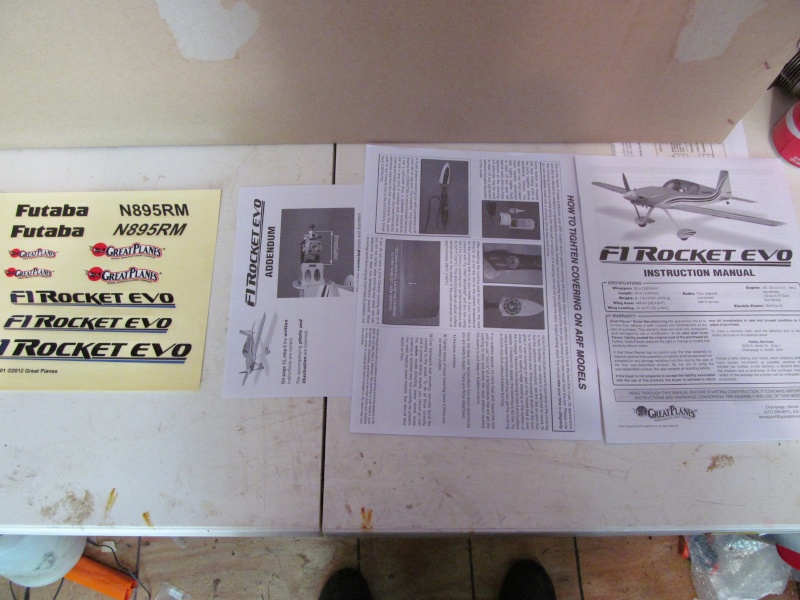
Now we get to start digging things out. when you pull the components out, inspect everything for damage or missing items then sit everything aside except the main parts (ie) Fuselage, wing halves, tail components etc and clear an area out and set everything on the table. The reason for this is with ARF's of ANY type it's not uncommon for the covering to come out of the box wrinkled, this is due to differences in temperature, humidity and such. so what we're gonna do in this step is tighten up and remove the wrinkles in the covering. This takes about an hour but is well worth the effort. To do this you can do it two ways (1) with a heat gun or (2) with a covering iron. If you elect to use a heat gun, keep in mind that while it will look just as good, it will be temporary it may take a while but the wrinkles will reappear in time. this is due to the covering being not stuck down properly at the factory since these models are mass produced so they don't always get the covering adhered and any place it isn't stuck down shows up as a wrinkle. The best way to do this is with number (2) the Covering iron, this will not only tighten up the covering but will properly stick down the covering hence eliminating the wrinkles and will stay tight longer too so I used the iron method
Begin by setting your iron using a iron thermometer. You want it just hot enough to stick down the covering and tighten it with out it forming bubbles or pulling away.
Next slowly move the iron over the entire part you are tightening up, paying attention to how the covering tightens up, if a bubble forms, (They can) use a sewing needle or the tip of a sharp #11 exacto blade poke the bubble and re run your iron over it and it will disappear. do this for the wings, fuselage, control surface anything that has monocote on it.
now once you are done, let it cool and look it over again for any more wrinkles, touching up areas that are missed. That's it!
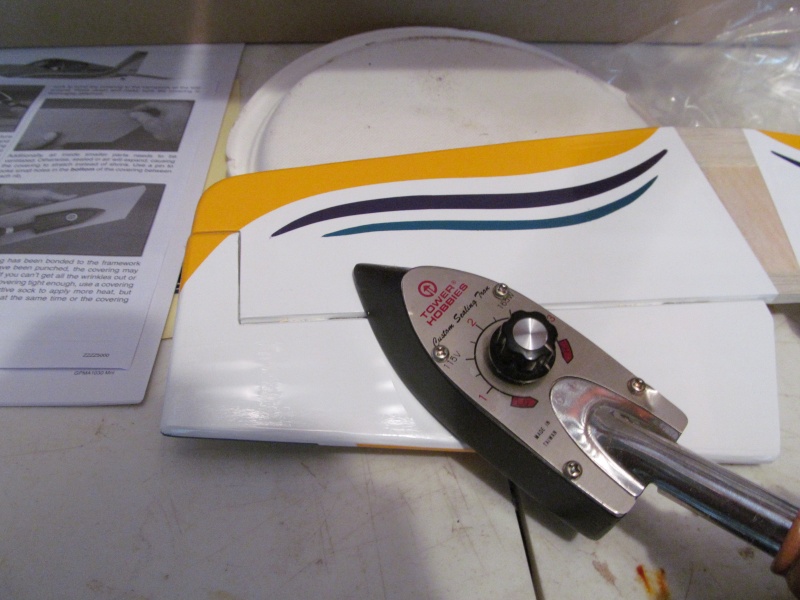
With everything tightened up now its time to set up your Transmitter (Study your transmitters manual!), bind your receiver if you are using a new 2.4G receiver and center the servo's. This is an important step because you have to select and set up the control arms and get them as close to 90deg as possible, why 90deg? it's because you want to keep things as linear as possible and makes for correct control geometry which is vital for a proper setup. also by setting up the servo arms now also helps you keep your settings in case you accidentally move a servo while assembling the model.
Here's a pic of my radio system centering the servo's
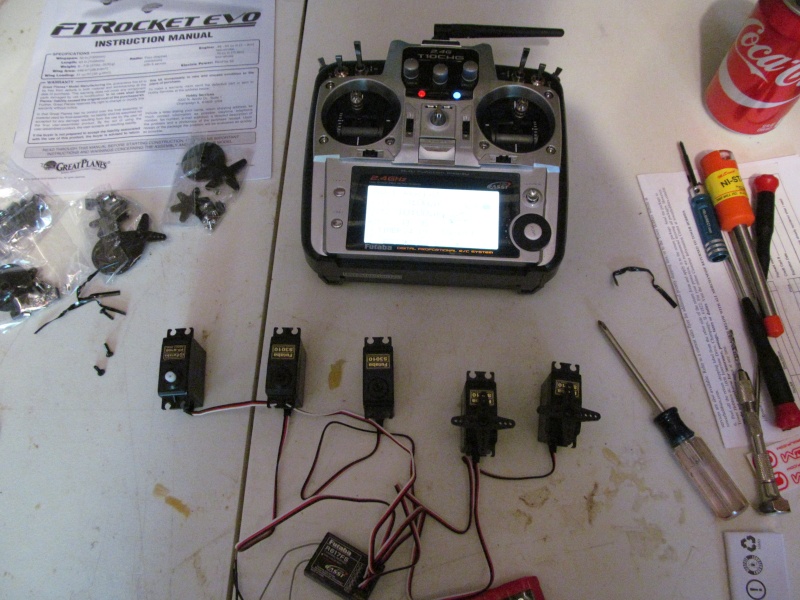
Now with all your servo's centered, it's time to install the little grommets on the servo's along with the crush sleeves (eyelets) (don't omit these little guys) They keep the servo's happy by absorbing vibration. A hard mounted servo is bad news especially with cheap servo's.
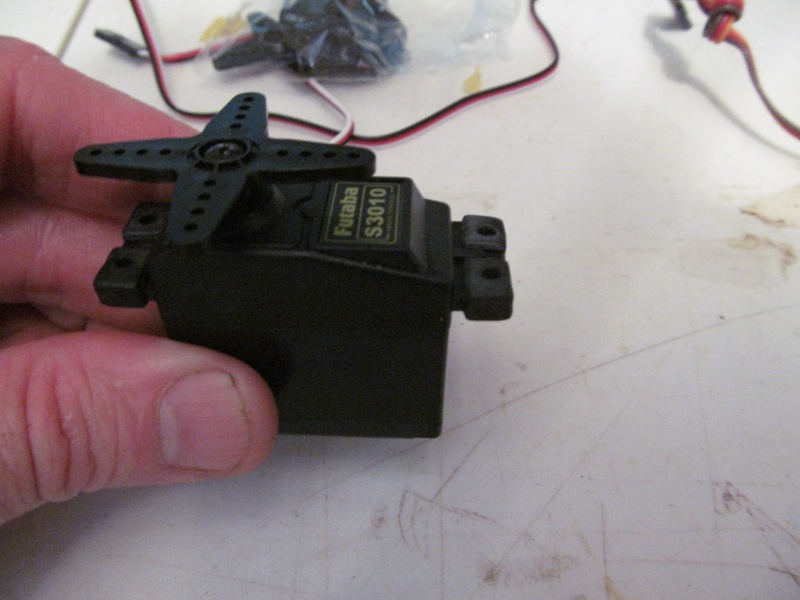
A little helpful trick for installing those pesky eyelets in the servo's (make sure the flange of the eyelet goes on the bottom of the servo lug.

Next, now we can get to building! First step is to assemble the aileron servo trays for the wings which calls for the tray itself and two 3/4 x 3/4 x 5/16 hardwood mounting blocks.
Very Important!! Use only epoxy for this step or any step involving the wings! Not only is it a stronger bond but the wings are foam cored sheeted with balsa. If you use CA especially thin CA it can leach through the balsa or in the case of the aileron servo compartments which is open foam, the CA can drip onto the foam and eat it up dramatically weakening the cores!
Using the servo to locate the mounting blocks, glue the blocks to the tray checking that the servo arm is centered in the slot in the tray. Remove the servo and let it cure. once cured, take a 1/16 drill bit in a pin vice and drill through the holes in the edges of the tray which are already drilled just clearing the covering in the holes and also through the tray and into the center of the servo mounting block then thread in a 5/64 washer head screw then remove it and using thin CA (not with it mounted in the wing!) soak it in the holes and let it set up then run the drill bit back through it to clear it out then reinstall the screws Repeat the same process for the other wing.
Now lay the servo back in the mount making sure it's in the right way and using the servo as a guide, drill four 1/16 holes for the servo mounting screws then using the mounting screws that came with the servo's, thread them in and back them out. Remove the servo and soak in some thin CA and once set, run the drill through it and reinstall the screws.


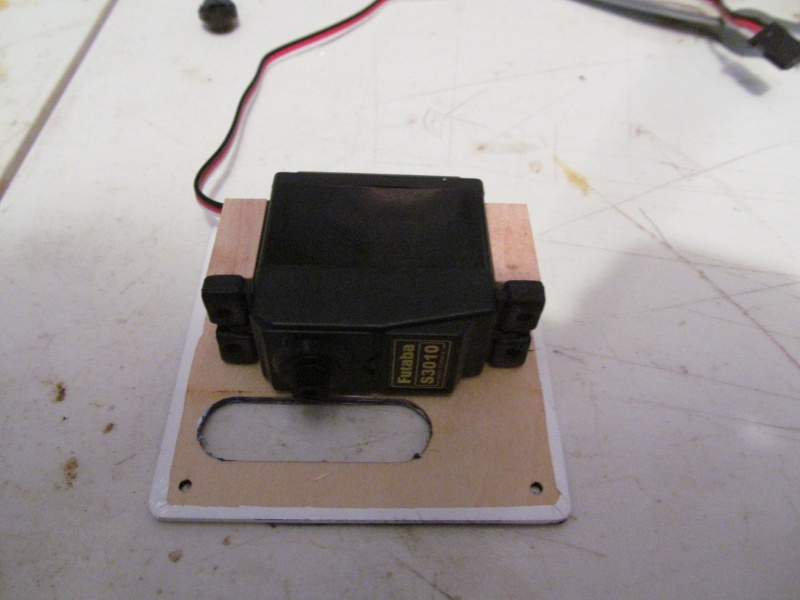
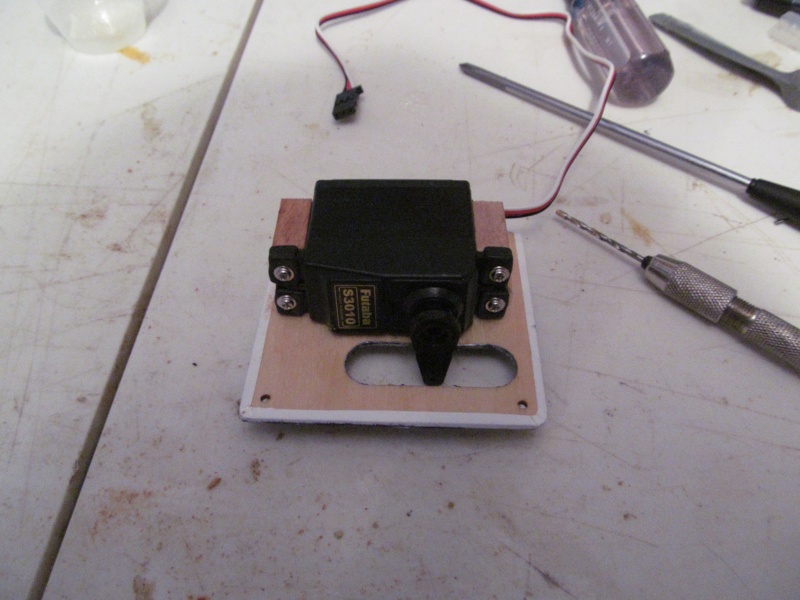
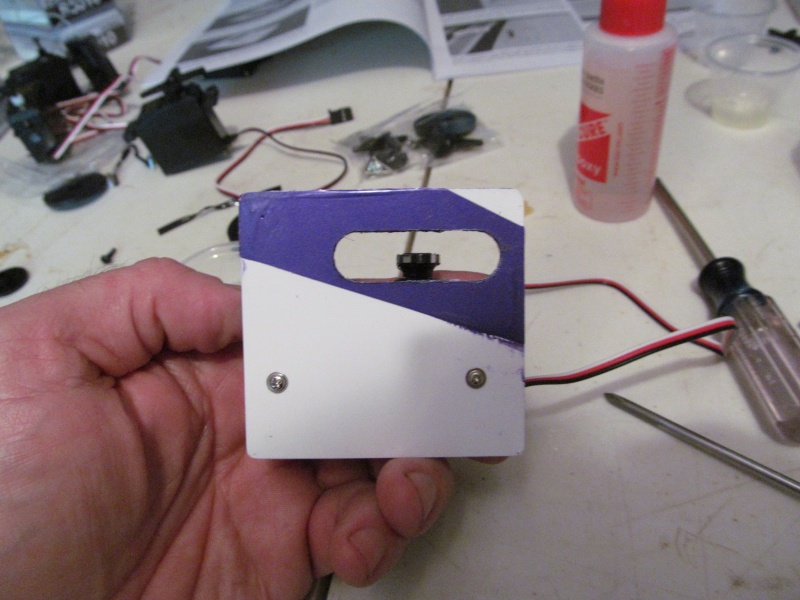
Ok that's about all for the night having a hard time holding my eyes open lol see ya next time.
(The banding flops over on the bed ZzZzZzZz)
First of all, Here is a small peak inside the box, this is a very nice ARF btw was very impressed with how everything went together.

First thing to do is to get things all together, while it's not really necessary to do this, it is good to do because it helps the assembly go quicker the servo's however are a requirement to begin assembly. You will need five (four if you build it electric powered) standard size servo's four high torque and one regular for throttle. I had an NOS Futaba S148 that I used on the throttle.

Next step is to open up your Data packet (instruction booklet ect) and lay them out and see what you have this is important because this is where any updates or bulletins addendum's are usually located make spechle note of any updates or error corrections. This is also a good time to open up the instruction manual and study it cover to cover this will make assembly so much easier and you will have an understanding on how everything goes. One thing to note though is to pay attention to the hardware, the manual is not too clear on the type of hardware that's in the hardware bag, the manual gives the length and such but not much info on the head types of the screws. Also make sure you have some thread locker.

Now we get to start digging things out. when you pull the components out, inspect everything for damage or missing items then sit everything aside except the main parts (ie) Fuselage, wing halves, tail components etc and clear an area out and set everything on the table. The reason for this is with ARF's of ANY type it's not uncommon for the covering to come out of the box wrinkled, this is due to differences in temperature, humidity and such. so what we're gonna do in this step is tighten up and remove the wrinkles in the covering. This takes about an hour but is well worth the effort. To do this you can do it two ways (1) with a heat gun or (2) with a covering iron. If you elect to use a heat gun, keep in mind that while it will look just as good, it will be temporary it may take a while but the wrinkles will reappear in time. this is due to the covering being not stuck down properly at the factory since these models are mass produced so they don't always get the covering adhered and any place it isn't stuck down shows up as a wrinkle. The best way to do this is with number (2) the Covering iron, this will not only tighten up the covering but will properly stick down the covering hence eliminating the wrinkles and will stay tight longer too so I used the iron method
Begin by setting your iron using a iron thermometer. You want it just hot enough to stick down the covering and tighten it with out it forming bubbles or pulling away.
Next slowly move the iron over the entire part you are tightening up, paying attention to how the covering tightens up, if a bubble forms, (They can) use a sewing needle or the tip of a sharp #11 exacto blade poke the bubble and re run your iron over it and it will disappear. do this for the wings, fuselage, control surface anything that has monocote on it.
now once you are done, let it cool and look it over again for any more wrinkles, touching up areas that are missed. That's it!

With everything tightened up now its time to set up your Transmitter (Study your transmitters manual!), bind your receiver if you are using a new 2.4G receiver and center the servo's. This is an important step because you have to select and set up the control arms and get them as close to 90deg as possible, why 90deg? it's because you want to keep things as linear as possible and makes for correct control geometry which is vital for a proper setup. also by setting up the servo arms now also helps you keep your settings in case you accidentally move a servo while assembling the model.
Here's a pic of my radio system centering the servo's

Now with all your servo's centered, it's time to install the little grommets on the servo's along with the crush sleeves (eyelets) (don't omit these little guys) They keep the servo's happy by absorbing vibration. A hard mounted servo is bad news especially with cheap servo's.

A little helpful trick for installing those pesky eyelets in the servo's (make sure the flange of the eyelet goes on the bottom of the servo lug.

Next, now we can get to building! First step is to assemble the aileron servo trays for the wings which calls for the tray itself and two 3/4 x 3/4 x 5/16 hardwood mounting blocks.
Very Important!! Use only epoxy for this step or any step involving the wings! Not only is it a stronger bond but the wings are foam cored sheeted with balsa. If you use CA especially thin CA it can leach through the balsa or in the case of the aileron servo compartments which is open foam, the CA can drip onto the foam and eat it up dramatically weakening the cores!
Using the servo to locate the mounting blocks, glue the blocks to the tray checking that the servo arm is centered in the slot in the tray. Remove the servo and let it cure. once cured, take a 1/16 drill bit in a pin vice and drill through the holes in the edges of the tray which are already drilled just clearing the covering in the holes and also through the tray and into the center of the servo mounting block then thread in a 5/64 washer head screw then remove it and using thin CA (not with it mounted in the wing!) soak it in the holes and let it set up then run the drill bit back through it to clear it out then reinstall the screws Repeat the same process for the other wing.
Now lay the servo back in the mount making sure it's in the right way and using the servo as a guide, drill four 1/16 holes for the servo mounting screws then using the mounting screws that came with the servo's, thread them in and back them out. Remove the servo and soak in some thin CA and once set, run the drill through it and reinstall the screws.





Ok that's about all for the night having a hard time holding my eyes open lol see ya next time.
(The banding flops over on the bed ZzZzZzZz)

TDbandit- Platinum Member

- Posts : 897
Join date : 2014-12-01
Age : 53
Location : Riverdale Georgia
 Re: GP F1 Rocket Evo RC airplane build
Re: GP F1 Rocket Evo RC airplane build
Ok took me a while to get some time but here's another segment of the build of the F1 Rocket.
In the last installment I built the aileron servo mount/trays now with the trays constructed, it is time to ready the trays for installation into the wing panels. First thing to do is to is to install the servo lead extensions which are self explanatory once hooked up as seen in the pic below, slip a piece of heat shrink tubing or another safety device to the extensions and secure it. Heat shrink tubing is great for this since the extensions will not be disconnected for storage so there will be no need for a quick disconnect safety and the shrink tubing is a permanent and secure way to safety the leads (don't bypass this step).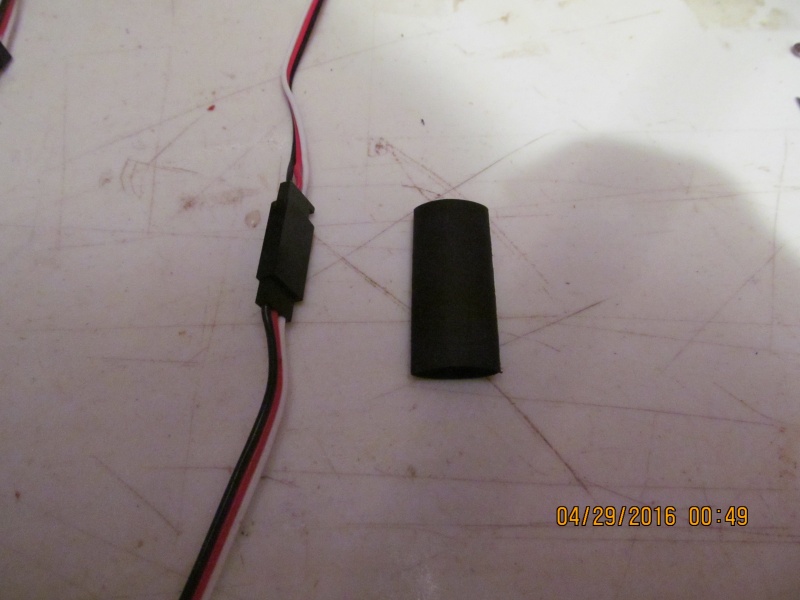
Now it's time to fish the leads through the wing panels and this is done by using some string which is already provided and is taped inside the wing panels in the servo tray recesses. All you do is simply tie one end of the string behind the connector of the servo lead and draw it through the wing panel, you can also use a thin piece of wire with a hook on the end to draw it through as well. do this slowly or you can embed the connector into the soft foam of the wing cores. (Note) make sure you have the right tray in the right panel (slot points toward the wing tips)
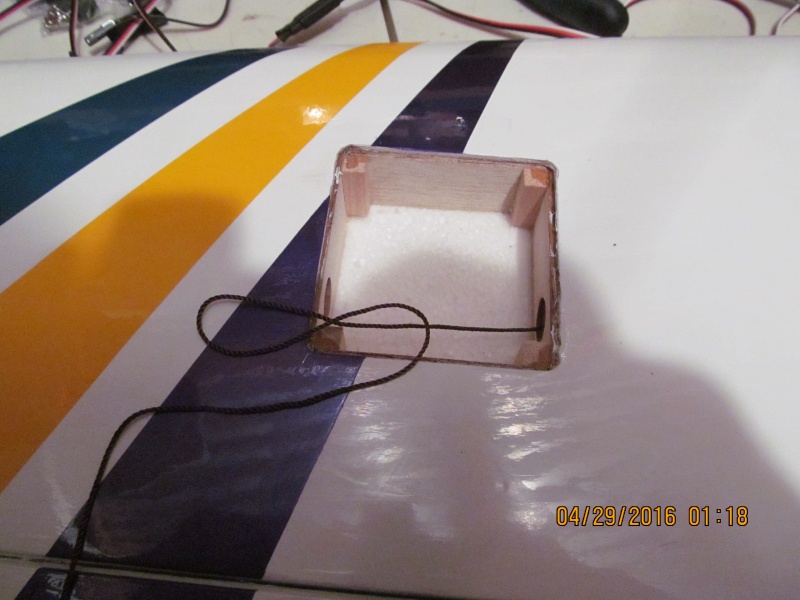

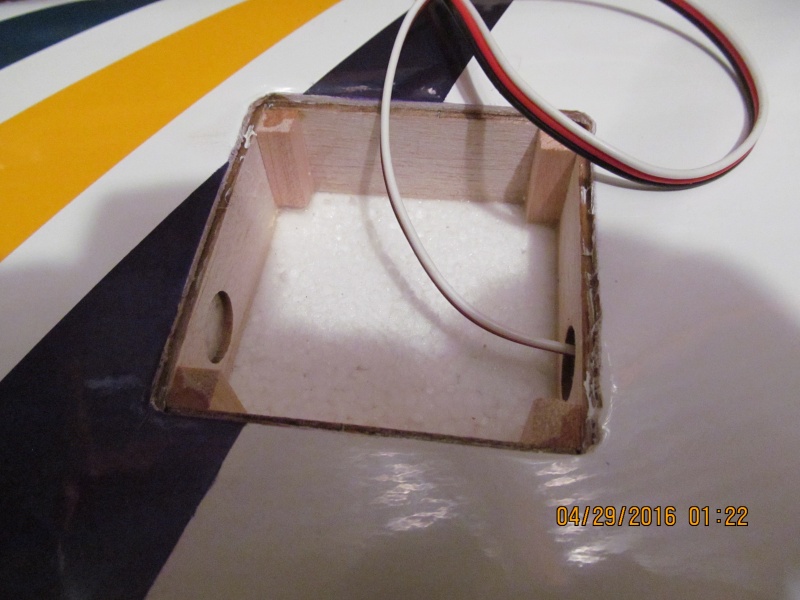


With the leads through the cores, lay the servo try in the servo tray chamber making sure it is pushed into the cutout then take a pen vice with a 1/16 drill bit and using the holes in the corners as a guide, drill the holes for the attachment screws. Then take four washer head screws and thread them in and then remove them and remove the tray now take some thin CA and CAREFULLY soak the hole and let it set (don't get any CA on the cores or the CA will eat the cores for breakfast!) once set run the drill back through the holes to clear them out and then reinstall the servo tray and reinstall the screws Repeat for the next panel.

This is all the time I have for today (got to head to work) i'll have more posted hopefully tomorrow take care!
(Bandit)
In the last installment I built the aileron servo mount/trays now with the trays constructed, it is time to ready the trays for installation into the wing panels. First thing to do is to is to install the servo lead extensions which are self explanatory once hooked up as seen in the pic below, slip a piece of heat shrink tubing or another safety device to the extensions and secure it. Heat shrink tubing is great for this since the extensions will not be disconnected for storage so there will be no need for a quick disconnect safety and the shrink tubing is a permanent and secure way to safety the leads (don't bypass this step).

Now it's time to fish the leads through the wing panels and this is done by using some string which is already provided and is taped inside the wing panels in the servo tray recesses. All you do is simply tie one end of the string behind the connector of the servo lead and draw it through the wing panel, you can also use a thin piece of wire with a hook on the end to draw it through as well. do this slowly or you can embed the connector into the soft foam of the wing cores. (Note) make sure you have the right tray in the right panel (slot points toward the wing tips)





With the leads through the cores, lay the servo try in the servo tray chamber making sure it is pushed into the cutout then take a pen vice with a 1/16 drill bit and using the holes in the corners as a guide, drill the holes for the attachment screws. Then take four washer head screws and thread them in and then remove them and remove the tray now take some thin CA and CAREFULLY soak the hole and let it set (don't get any CA on the cores or the CA will eat the cores for breakfast!) once set run the drill back through the holes to clear them out and then reinstall the servo tray and reinstall the screws Repeat for the next panel.

This is all the time I have for today (got to head to work) i'll have more posted hopefully tomorrow take care!
(Bandit)

TDbandit- Platinum Member

- Posts : 897
Join date : 2014-12-01
Age : 53
Location : Riverdale Georgia
 Re: GP F1 Rocket Evo RC airplane build
Re: GP F1 Rocket Evo RC airplane build
There are some very useful tips here.
Centering servos before installing them save a great deal of effort and frustration later on. Also making sure that the servos are mounted as vibration free as possible.
When extending leads - I don't use heat shrink tubing but prefer to use the special clips for locking the plugs/sockets together. I do this because often my models don't last long and it makes it easier to reuse parts!
I haven't had an ARF arrived wrinkled yet - must be the English climate but I never thought that the covering might not be stuck down properly in the factory because the covering always looks tight. That is something I should look at.
For me - fuel proofing isn't an issue as mine are of a different persuasion but I have often wondered when assembling one what approach I would use.
The wood is very light and I can imagine it getting fuel soaked rather quickly. Not just the engine bay.
The servo trays on mine have no finish applied inside and I have been known to fly in the rain and end up with soggy balsa. While that has dried out (sort of!) - I wouldn't fancy coping with an exhaust residue soaking and I know some foams aren't fuel proof - definitely not diesel fuel proof!
Waiting for the next installment.
Centering servos before installing them save a great deal of effort and frustration later on. Also making sure that the servos are mounted as vibration free as possible.
When extending leads - I don't use heat shrink tubing but prefer to use the special clips for locking the plugs/sockets together. I do this because often my models don't last long and it makes it easier to reuse parts!
I haven't had an ARF arrived wrinkled yet - must be the English climate but I never thought that the covering might not be stuck down properly in the factory because the covering always looks tight. That is something I should look at.
For me - fuel proofing isn't an issue as mine are of a different persuasion but I have often wondered when assembling one what approach I would use.
The wood is very light and I can imagine it getting fuel soaked rather quickly. Not just the engine bay.
The servo trays on mine have no finish applied inside and I have been known to fly in the rain and end up with soggy balsa. While that has dried out (sort of!) - I wouldn't fancy coping with an exhaust residue soaking and I know some foams aren't fuel proof - definitely not diesel fuel proof!
Waiting for the next installment.

ian1954- Diamond Member

- Posts : 2688
Join date : 2011-11-16
Age : 70
Location : England
 Re: GP F1 Rocket Evo RC airplane build
Re: GP F1 Rocket Evo RC airplane build
Good thread. Sorry it took me so long to get to it.
Rusty
Rusty
_________________
Don't Panic!
...and never Ever think about how good you are at something...
while you're doing it!
My Hot Rock & Blues Playlist
...and never Ever think about how good you are at something...
while you're doing it!
My Hot Rock & Blues Playlist

RknRusty- Rest In Peace

- Posts : 10869
Join date : 2011-08-10
Age : 68
Location : South Carolina, USA
 Re: GP F1 Rocket Evo RC airplane build
Re: GP F1 Rocket Evo RC airplane build
Ok i'm back for another installment, sorry for taking so long.
Since the aileron servo trays were installed in the previous steps, it is now time to install the aileron linkage.
To begin this you need to first take a steel or plastic scale (ruler) and using a fine tip sharpie draw a line from the center of the servo arm inline with the slot with the tray so the linkage will have a straight shot to the control horn that will be later installed onto the ailerons. This line will also be used to locate the control horn so it's location will be in the proper place to except the linkage
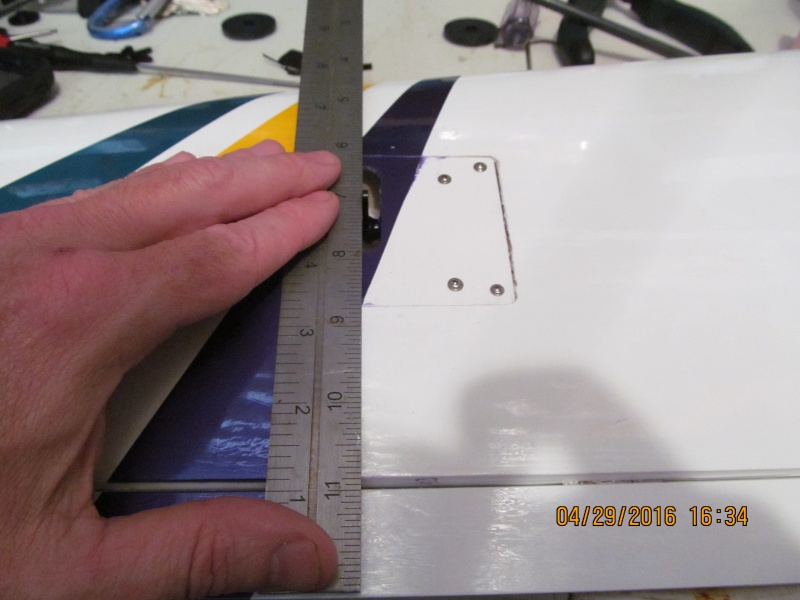
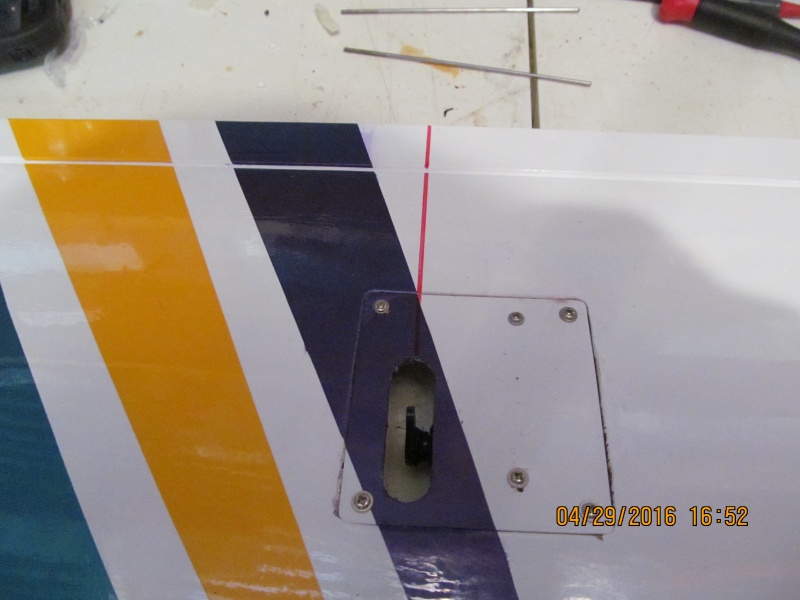
Next is to go and collect the parts to construct the aileron linkage. which consists of two short 2-56 threaded rods located in the push rod pack, two clevises, nylon EZ connectors and two rubber clevis keepers along with the control horns and and four 2-56 screws as indicated in the manual. Now assemble the pushrods by slipping the rubber keeper over the back end of the clevis (don't forget these things) and using a pair of pliers, secure the pushrod and install the clevis 20 full turns each and set them aside.
Next cut the back plates free of the control horns and trim them smooth and install the control horns using the lines drawn earlier as a reference to keep them straight (Important!) When installing the control horns make sure the holes in the control horn align with the hinge line (center of the gap) this is so that you will keep your control throw geometry which means you will have equal throw both ways which will simplify radio setup later. Once you have the control horns positioned properly use a thin tipped felt tip marker or pin vice with 1/16 bit to mark and drill the holes for the horns and using the 2-56 screws and back plates, secure the horns being careful not to over tighten them.
Now secure the ailerons using tape on the ends then take the linkage that you previously assembled and connect the clevis to the outer most hole on the control horn, then confirm that the servo's are still centered and using a drill bit appropriate for the linkage rod size, enlarge the outer most hole in the servo arm. Then take the linkage rod and align it with the hole you just drilled then mark the rod and make a 90 degree bend and trim off the excess but leave enough about 5/16 so that the EZ connectors can be installed with a little of the rod protruding from the side and install the rods to the horns using the EZ connectors. Repeat for the other panel.

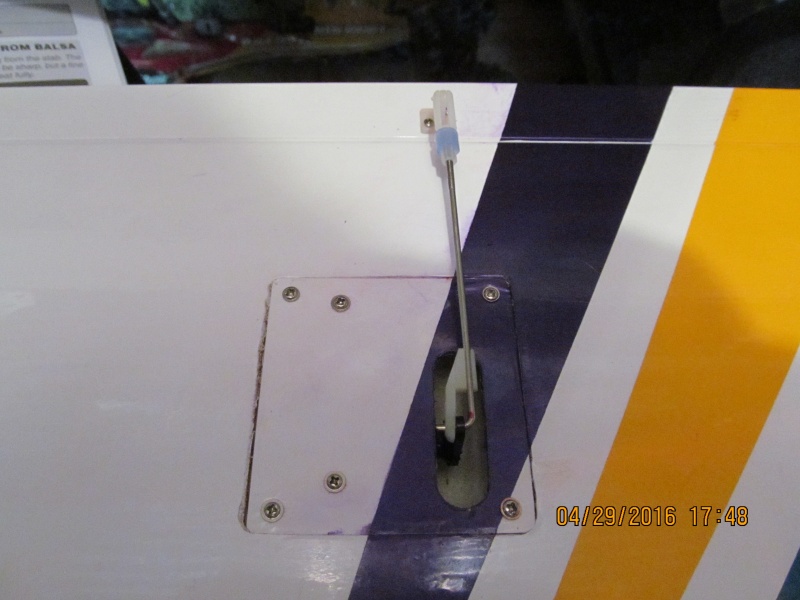
Now with the ailerons setup, it is time to prepare the wing panels for joining. This series of steps is where you must pay attention especially when involving the spar joiner so study the manual well.
First, rummage through the plastic parts bag and find the little fiberglass locator peg (you may have to dump the bag out to find it since it is rather small) and lightly sand the peg then mark it half way. Now choosing a wing panel, locate the small hole near the trailing edge and mix up a small amount of 5 min epoxy, install the peg up to the mark and clean up any excess epoxy using denatured alcohol and let it set up.
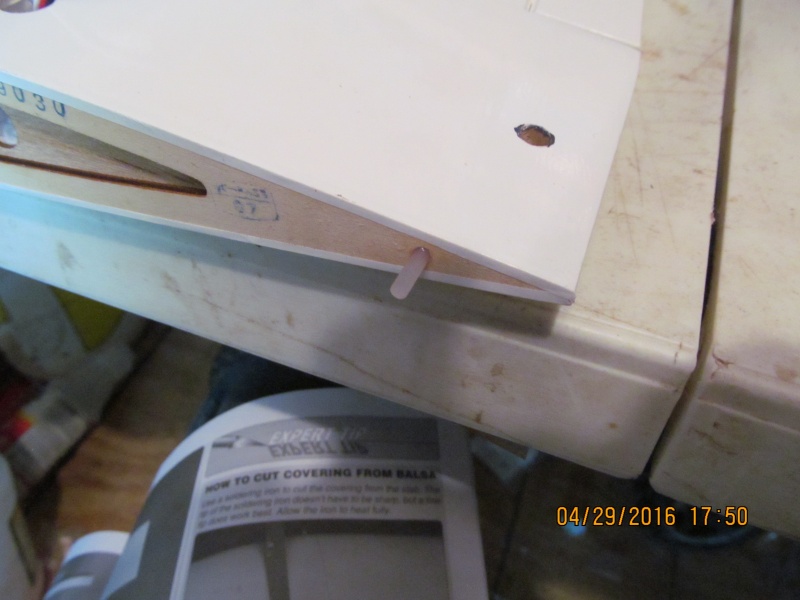
Once the epoxy has set, take the wing spar joiner and study it's orientation, the V side Must point up VERY IMPORTANT! This not only joins the wings together and provides strength, but it also sets the dihedrial. Putting this thing in upside down will cost you a wing! Once you have the joiner ID'ed mark the joiner to identify which side is up. Now dry fit the joiner into the slot in the spar in both wing panels then dry fit the wing halves together with the joiner, aligning the locator pin in the other half and butt the halves together, there should be no gap also insure that the LE and TE align as well, once satisfied separate the wing halves.
Now mix up a generous portion of 30min epoxy making sure you get the portions correct since this is a high stress area soft epoxy is not a good idea and generously apply epoxy to the joiner slot, joiner itself both sides btw wing root and the alignment pin hole and again slide the wing halves back together insuring the alignment pin is in it's hole then take the wing bolts and insert them in the mounting holes in the TE and take a couple of #64 rubber bands, rubber band the TE together using the bolts as means to secure the rubber bands, then take a small wood clamp and clamp the mounting tongue at the LE and clean off any epoxy that squeezes out with denatured alcohol and then tape the wing and support the wing and let it setup over night


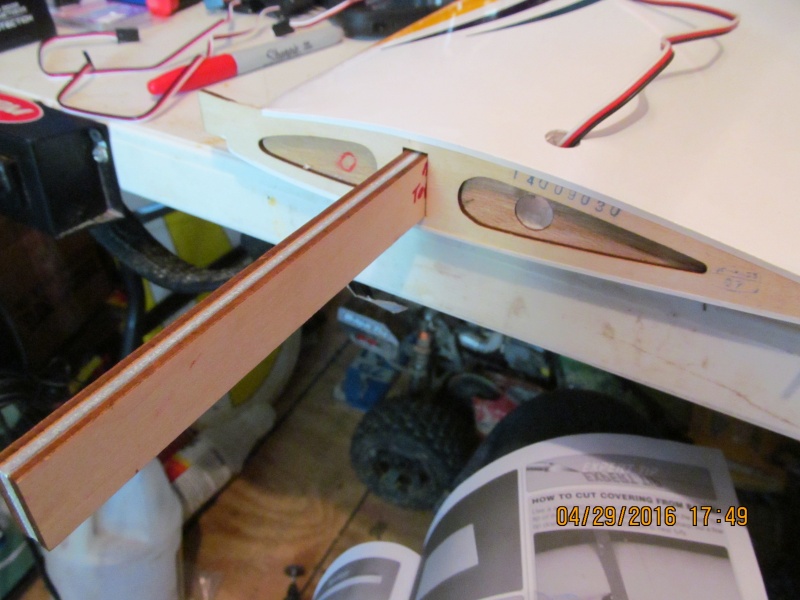
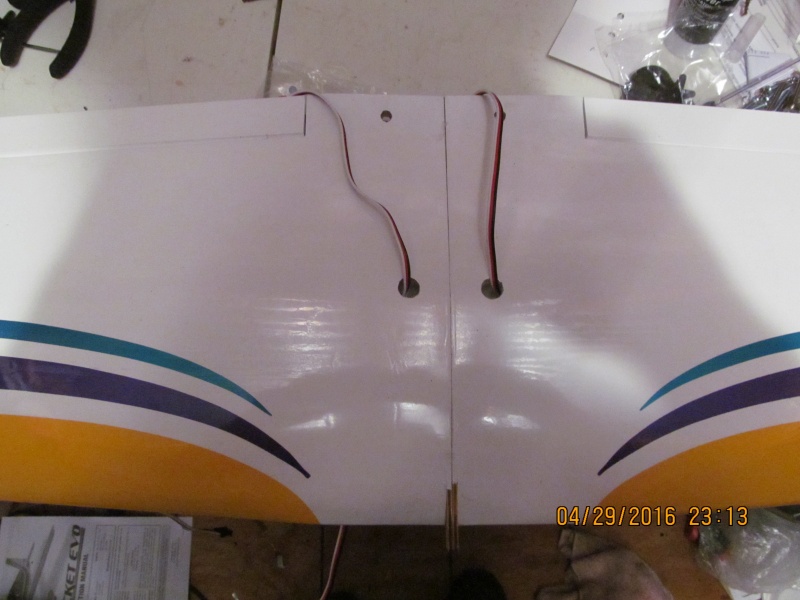
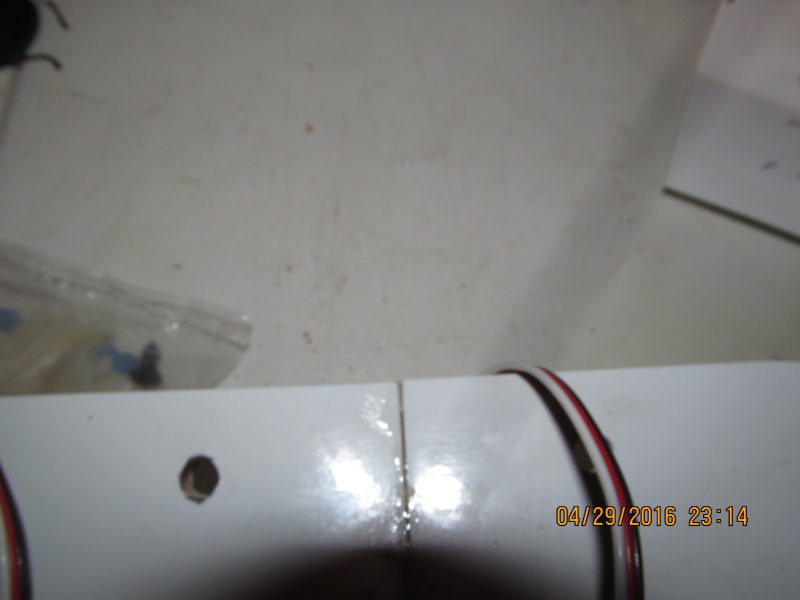
Ok this is it for the night folks time for the bandit to catch some ZzZ....THUMP!!! (The bandit flunks over asleep)
Since the aileron servo trays were installed in the previous steps, it is now time to install the aileron linkage.
To begin this you need to first take a steel or plastic scale (ruler) and using a fine tip sharpie draw a line from the center of the servo arm inline with the slot with the tray so the linkage will have a straight shot to the control horn that will be later installed onto the ailerons. This line will also be used to locate the control horn so it's location will be in the proper place to except the linkage


Next is to go and collect the parts to construct the aileron linkage. which consists of two short 2-56 threaded rods located in the push rod pack, two clevises, nylon EZ connectors and two rubber clevis keepers along with the control horns and and four 2-56 screws as indicated in the manual. Now assemble the pushrods by slipping the rubber keeper over the back end of the clevis (don't forget these things) and using a pair of pliers, secure the pushrod and install the clevis 20 full turns each and set them aside.
Next cut the back plates free of the control horns and trim them smooth and install the control horns using the lines drawn earlier as a reference to keep them straight (Important!) When installing the control horns make sure the holes in the control horn align with the hinge line (center of the gap) this is so that you will keep your control throw geometry which means you will have equal throw both ways which will simplify radio setup later. Once you have the control horns positioned properly use a thin tipped felt tip marker or pin vice with 1/16 bit to mark and drill the holes for the horns and using the 2-56 screws and back plates, secure the horns being careful not to over tighten them.
Now secure the ailerons using tape on the ends then take the linkage that you previously assembled and connect the clevis to the outer most hole on the control horn, then confirm that the servo's are still centered and using a drill bit appropriate for the linkage rod size, enlarge the outer most hole in the servo arm. Then take the linkage rod and align it with the hole you just drilled then mark the rod and make a 90 degree bend and trim off the excess but leave enough about 5/16 so that the EZ connectors can be installed with a little of the rod protruding from the side and install the rods to the horns using the EZ connectors. Repeat for the other panel.


Now with the ailerons setup, it is time to prepare the wing panels for joining. This series of steps is where you must pay attention especially when involving the spar joiner so study the manual well.
First, rummage through the plastic parts bag and find the little fiberglass locator peg (you may have to dump the bag out to find it since it is rather small) and lightly sand the peg then mark it half way. Now choosing a wing panel, locate the small hole near the trailing edge and mix up a small amount of 5 min epoxy, install the peg up to the mark and clean up any excess epoxy using denatured alcohol and let it set up.

Once the epoxy has set, take the wing spar joiner and study it's orientation, the V side Must point up VERY IMPORTANT! This not only joins the wings together and provides strength, but it also sets the dihedrial. Putting this thing in upside down will cost you a wing! Once you have the joiner ID'ed mark the joiner to identify which side is up. Now dry fit the joiner into the slot in the spar in both wing panels then dry fit the wing halves together with the joiner, aligning the locator pin in the other half and butt the halves together, there should be no gap also insure that the LE and TE align as well, once satisfied separate the wing halves.
Now mix up a generous portion of 30min epoxy making sure you get the portions correct since this is a high stress area soft epoxy is not a good idea and generously apply epoxy to the joiner slot, joiner itself both sides btw wing root and the alignment pin hole and again slide the wing halves back together insuring the alignment pin is in it's hole then take the wing bolts and insert them in the mounting holes in the TE and take a couple of #64 rubber bands, rubber band the TE together using the bolts as means to secure the rubber bands, then take a small wood clamp and clamp the mounting tongue at the LE and clean off any epoxy that squeezes out with denatured alcohol and then tape the wing and support the wing and let it setup over night





Ok this is it for the night folks time for the bandit to catch some ZzZ....THUMP!!! (The bandit flunks over asleep)

TDbandit- Platinum Member

- Posts : 897
Join date : 2014-12-01
Age : 53
Location : Riverdale Georgia
 Similar topics
Similar topics» 1/2A airplane Release Build
» Guppy 2 channel rc airplane build
» Looking for: Easy to build basic RC airplane plans
» RARE COX THIMBLE DROME PROTOTYPE "PT-19 COROPLAST BUILD" GAS MODEL AIRPLANE
» I build Rene's wacky Cox tri-motor pontooned tether car/airplane among other things
» Guppy 2 channel rc airplane build
» Looking for: Easy to build basic RC airplane plans
» RARE COX THIMBLE DROME PROTOTYPE "PT-19 COROPLAST BUILD" GAS MODEL AIRPLANE
» I build Rene's wacky Cox tri-motor pontooned tether car/airplane among other things
Page 1 of 1
Permissions in this forum:
You cannot reply to topics in this forum

 Rules
Rules







